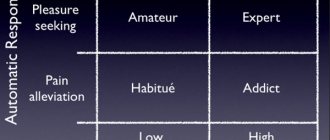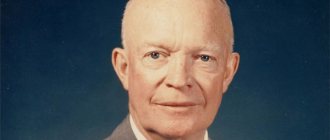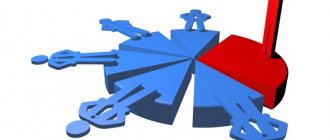What kind of person is considered beautiful today? How and by whom are modern standards of beauty formed? Why does a healthy person undergo surgery and can a plastic surgeon make us beautiful?
Active rejection of one's own body in the form in which it is located is the main and only reason for surgery. The reasons for this rejection may be different. Attempts to change one's appearance in adulthood may be dictated by the desire to increase one's social status and gain public approval.
They meet you by their clothes
According to experts, more and more men and women are resorting to plastic surgery due to fierce competition in the professional field. This is due to the fact that the image of a business person is associated with tone, youth, health, and a athletic figure. A “healthy person” evokes more trust than an overweight person, who is associated with promiscuity and lack of obligation. To start a career, you need a “presentable appearance” - this is stated in almost all descriptions of prestigious vacancies. Appearance is the first thing people pay attention to.
During adolescence, the body begins to change too quickly and not always in the direction you want. It’s rare that a teenager will react with philosophical calm to disproportionate limbs, enlarged facial features and acne scars. Eventually, the pace of change slows down, and the matured person has time to get used to his new reflection in the mirror.
But if during this difficult period a teenager does not develop relationships with the opposite sex, there is a high probability that responsibility for the troubles will be placed on an overly large nose or childishly chubby cheeks. And then a visit to a plastic surgeon will be tantamount to the statement: “My big nose prevents people from loving me.”
Sensory shape standards
Shape standards are geometric figures. Children begin to get acquainted with them with the simplest shapes: square, circle, oval, rectangle and triangle. Trapezius learning can then be introduced. But in all cases, children must be able to recognize the corresponding forms, name them and act in accordance with their properties, as well as analyze them.
Children can be introduced to varieties of shapes such as ovals, which have different axial ratios. These can also be rectangles that have different aspect ratios. These can be acute, right or obtuse triangles. It is important that children are able to distinguish these types of triangles by eye, but they are not required to remember their names [Maltseva, 2008].
It is also advisable to use volumetric and planar figures. Three-dimensional figures are less generalized. Planar ones make it possible to reflect the most important properties for perception - this is the contour. They can be used as samples with which children could perceive shapes for flat and three-dimensional objects. For example, a ball can be expressed using a circle. He also depicts a plate.
This allows the use of generally flat figures during sensory perception. After all, bulky objects will cause additional difficulties at first.
40+
The next surge of interest in plastic surgery occurs around the age of forty. Age-related changes in appearance surprisingly coincide with a midlife crisis. If anti-aging procedures do not give the desired effect, many decide to undergo plastic surgery.
Someone strives to “catch up with youth” by arranging their personal life. Someone proves to the world the right to exist in a certain circle, where looking your age is indecent. There are also those who view cosmetic surgery as a kind of “rebirth” in an effort to part with their past.
Sensory color standards
Sensory standards in the form of color are usually chromatic and achromatic colors, which are found in the spectrum in a certain sequence from red to violet according to how the wavelength of light changes.
If you mix two colors that are not next to each other in the spectrum, you can get an intermediate color. If you mix two adjacent colors, you get an additional shade. You can distinguish between cold and warm chromatic colors. First, children learn to perceive white and black and chromatic colors. All this creates the prerequisites for successful learning of color names.
Typically, six color tones are introduced at first. Blue is excluded in this case, because it is difficult for children to learn. This color is best taught at a later stage, when preschoolers have an idea of what shades are, where color tones are located on the spectrum, and how they can be divided into cool and warm.
What is behind the motives?
If a person is aware of his motives, understands what is behind them, and still goes to a plastic surgeon, then a favorable result of the operation can really help solve personal problems. I emphasize, contribute, but not decide. A person who adequately assesses the possibilities of aesthetic surgery will actively “tighten up” not only his face, but also other aspects of his own life.
The desire to change one’s own body is always dictated by rather complex psychological motives, and it is very important to clarify them before one’s appearance undergoes significant and often irreversible transformations. Often, a person on his own cannot understand the true reasons that force him to go to the clinic to see surgeons. A psychologist can help you realize your true motives, which, as a rule, are unsatisfied needs for recognition, love, and family well-being.
The fact of awareness of these needs allows the client to realistically assess the consequences of the operation. Yes, by changing the shape of your nose, breasts, or making an anti-aging correction, at first you can only expect a change in your own perception of your appearance, after which a long process of internal and external personality transformations begins.
Sensory standards as samples
Sensory standards are patterns that are developed by people that children must learn in order to successfully learn in the future at school. The development of these skills occurs gradually from a very early age. The formation of sensory abilities should be carried out during this period, while knowledge about the surrounding world is accumulated.
Preschool age is characterized by the fact that the main sensory standards in children are colors and shades, geometric shapes, the size of things, the characteristics of musical sounds, and the pitch of the voice.
Humanity has developed these standards over thousands of years. And kids should master them in the first years of their lives. The teacher and parents should strive to help children master these sensory standards. It is necessary to create all the conditions for the development of ideas about surrounding objects. This happens when children play educational games, when they work or study, when they sculpt or draw, when they walk or go on excursions.
Each age has its own characteristics that need to be taken into account when mastering sensory standards. Let's discuss them in more detail.
Postoperative crisis
After plastic surgery, a person often experiences a deep internal conflict - a conflict between the external and internal images of “I”. With the help of a psychologist, you can see your problem more clearly and realize what you are really deciding in your life? The concept of beauty is very multifaceted, and in our age there is no single standard of beauty. Finding harmony and individuality within yourself is what beauty is.
A beautiful person is, first of all, a psychologically mature and harmonious person. A lot depends on how we feel in both interpersonal and professional relationships. To become successful in business and happy in your personal life, you must first learn to accept yourself.
There are no perfect people among us. Perfection is identical to infinity. One can only strive for it. It is better to learn to accept yourself and improve your individuality in contact with a trained psychologist. Despite the fact that the vast majority of patients who resort to aesthetic surgery are normal, ordinary people without any problems in the field of psychology or psychiatry, among them there are people who, due to their psychological make-up, represent a risk group for undergoing surgery.
Thanks to the level of modern plastic surgery, any of us today has the opportunity to change our appearance. But does such a transformation always bring happiness and get rid of complexes? For many people, plastic surgery really helps them gain self-confidence. But there is also a category of people who are dissatisfied with their own appearance and for whom plastic surgery is simply contraindicated.
Sensory standards and types of ideas about properties
Mastery of sensory standards allows you to use varieties and ideas about each property to analyze and determine the properties of different objects in certain situations. This means that they can be used as units of measurement. And we begin to introduce children to sensory standards at an early stage.
The word is of great importance when studying sensory standards. In the process of perception, children accumulate auditory, visual, gustatory, tactile and olfactory images.
But at the same time, it is important that the relationships and properties of objects that are perceived by the child are indicated in words that would allow images of objects to be consolidated in the mind, making them clearer and more durable. If these images are fixed in words, they can be evoked in a child’s imagination even at those moments when some time has already passed after direct perception.
To do this, you need to pronounce the corresponding names of words. Thus, it is with the help of words that one can consolidate the resulting images, which are formed on the basis of ideas.
What is dysmorphophobia
We are talking about those for whom the idea of their own physical disability has turned into a painful passion. In the case when worries about one’s own appearance become the main plot of a person’s life, they speak of body dysmorphic disorder .
You've probably met people who categorically refuse to be photographed and avoid video cameras. They will spend hours studying the slightest flaw in appearance in the mirror, always with disappointing results. Anorexia, a notorious diagnosis, is also a variant of body dysmorphic disorder.
Treatment of dysmorphophobia should be carried out by a psychotherapist; plastic surgery can worsen the condition of such patients. Also, surgeons who value their good name rarely undertake the task of “adjusting” normal appearance to the “ideal”. Narcissistic individuals who demand to bring themselves to anatomical perfection are ungrateful clients, as they are rarely satisfied with the results. In addition, the risk from surgery and general anesthesia far outweighs the benefits of those millimeters by which the shape of the face and body can be polished.
There are two more inadequate options for requests to a plastic surgeon, when the patient demands to “redo everything.”
- The first sounds like “Doctor, I don’t like myself, help me” and involves not only a large number of operations, but also the active participation of the doctor in developing a new image.
- The second option is more specific: “I want to be like Angelina Jolie, period.”
Fortunately, most clients choose to remain themselves when improving their appearance. Stamped faces emerging from under the scalpel of the same doctor are rather a sign of medical unprofessionalism.
The skill of a plastic surgeon lies precisely in preserving the individuality of the patient. So, the problem of rejection of one’s own body in the 20th – 21st centuries has become extremely relevant. Of course, because in our time the cult of top models and Hollywood actresses, the notorious 90-60-90 and grueling diets has reigned in the world. And popular shows with the main idea “go to a plastic surgeon and your life will change” only add fuel to the fire.
As a result, the fear of imperfection turned into a collective panic... And the most suggestible were captured by the terrible fear of inadequacy. According to psychologists, anything can plunge a person into such an unpleasant state: an “affectionate” school nickname, a casual remark from a passerby, an overheard fragment of a phrase. Moreover, there is an information field literally teeming with ideas about the “ideal” person.
And although the stressful situation itself is often already forgotten, the instantly formed complex can grow into a huge problem, which you can no longer get rid of without the help of a psychologist. Moreover, sometimes a categorical rejection of appearance is a manifestation of other serious mental illnesses.
Sensory standards of magnitude and measures
Standards of magnitude are endowed with a special character. Since quantity is a relative property, its precise determination can be made using conditional measures.
The system of measures was deliberately created by people. At the same time, some arbitrary unit was always taken as its basis. But geometric shapes are actually distractions from the shape of real objects.
Studying the system of measures and methods of their application is an important task that requires mathematical training and is not included in the curriculum for preschoolers. But we cannot always use the metric system when perceiving objects.
The size of an object can be determined depending on the place it occupies in a series of homogeneous objects. For a child, a big cat is a cat that is larger in size than ordinary cats. But at the same time, it still remains smaller than a small elephant. Therefore, the standard of magnitude is usually the idea of what size the object in question should have.
Disadvantages, real and imaginary
Perhaps there is not a single person who is completely satisfied with his appearance. Some people are haunted by a large nose or a few “extra” kilograms. But most people remember these troubles only in front of the mirror, and the rest of the time they live as if nothing had happened. But there are also those whose entire thoughts are focused on their physical defect. These shortcomings can be true or imaginary .
A person can be incredibly upset by a large wart in the middle of his nose, which really does not add to his beauty. In this case we are talking about a true disadvantage. It’s more difficult with imaginary shortcomings. So, for example, a girl with a clothing size of 46 may be haunted by the thought of beginning obesity. In addition to suffering from their “disadvantage,” the unfortunate have to deal with misunderstanding and often ridicule from loved ones.
Almost all of us suffered from dysmorphophobia during adolescence. This is natural: a teenager's body changes quickly, and it takes some time to get used to it and find it natural and beautiful. Most often, teenage dysmorphophobia is associated with signs of growing up. Young men worry about the size and shape of their genitals, as well as lack of muscle mass. Girls - because of excess weight. At the same time, both of them worry about acne and the shape of the nose.
Teenage body dysmorphic disorder usually goes away by senior year. But sometimes it remains and takes on truly ugly forms. A person becomes completely focused on his “flaw” and it becomes an obsession. As a result, life turns into hell: I’m afraid to get a job that involves communication, I’m afraid to make friends, I’m not even talking about my personal life! At the same time, a person spends enormous efforts, a lot of time and money to eradicate his “problem”.
Concept of magnitude
In early preschool age, special attention is paid to the sensory standard “size”. This is one of the tasks of mental education, thanks to which the child learns not only to give the correct name to the properties of objects, but also to compare them with each other, which gives the child a more complete understanding of the reality around him. Measuring activities develop thinking, serve as the basis for various types of activities, and create prerequisites for studying at school.
Sensory standards of magnitude are first cognized at the level of the senses, that is, on a sensory basis. The child sees an object with his eyes, feels it, and performs a series of actions with it. Then the perceived object is comprehended by thinking, and knowledge is supplemented by speech. The mechanism of perception itself is the same in both adults and children. Knowledge and concepts about a subject come as a result of practical activity, with the participation of words and reflection. The processes of comparison and analysis, synthesis and classification are involved, which are already signs of logical thinking.
Three-year-old children cannot yet differentiate objects based on differences in size. So, a baby may try to put a big bear into a small crib. After this period, the child begins to distinguish objects by their appearance, starting from their volume. So, the hippopotamus is big, and the mouse is small. With age and speech development, children already identify individual signs of size, distinguishing length, width, height, thickness. It is still difficult for them to remember the correct name of all these properties of an object, so the teacher conducts didactic games with them, the purpose of which is to compare objects by size and correctly name the characteristics. All of these educational exercises are based on comparing quantities using the child's eye.
All this is reinforced in practice in different types of activities. When designing, a child will not place a small piece at the bottom, because he understands that the entire structure will fall apart. When drawing a picture, an older preschooler already correlates the size of objects with distance. So, trees that grow close are drawn large, and those that grow far away are small.
Causes of dysmorphophobia
The causes of dysmorphophobia can be divided into two large groups.
The first is psychological trauma. For example, someone once made an unsuccessful joke about the shape of a young man’s nose, this was combined with some kind of stress, and as a result, we have the Cyrano de Bergerac complex in all its glory. Even watching TV can be a traumatic factor. Now there are many programs about plastic surgeries built on this principle: Petya (Oli, Ivan Ivanovich) had a physical disability, he had surgery, he became beautiful, successful and happy, which would never have happened if he had remained “ugly”. For a person who feels like a failure, has recently suffered a collapse in a personal relationship, or is simply quite impressionable, such a transfer can become a trigger that sets off the mechanism of body dysmorphic disorder.
The second possible cause of dysmorphophobia is a serious mental illness. Usually we are talking about an anxiety disorder that leads to obsessive thoughts. Even if we convince such a person that his profile resembles a Greek god, this will not help him much. After all, anxiety disorder has not gone away! Instead of the old obsession, he immediately develops a new one. He will not be satisfied with the shape of his ears, eyes or kneecaps - it doesn’t matter, there will always be an object of dissatisfaction.
Body dysmorphic disorder can also be associated with serious mental illness. In this case, it is simply part of a delusional concept. It is useless to treat such dysmorphophobia in itself, because it is based on a more serious disease that needs to be dealt with first, and dissatisfaction with appearance is just a symptom.
How can you determine that a person’s attitude towards his own appearance has become inadequate? First of all, candidates for body dysmorphic disorder have a very specific personality type. Most often these are timid, shy, anxious people. In adults, this may be accompanied by demonstrative behavior, egocentrism, suggestibility, and some infantilism. Such people are characterized by a tendency to depression and rapid mood swings. We are not talking here about fleeting dissatisfaction with oneself, to which all women are susceptible to one degree or another.
For example, a lady quarreled with her husband or received a reprimand from her boss. She looks in the mirror and, due to stress or just a bad mood, seems ugly or fat. But as soon as she calms down a little or receives a couple of compliments, her dissatisfaction naturally disappears.
The situation is different for those who are truly fixated on their shortcomings. This condition is always accompanied by depression. A person begins to refuse to communicate with friends, go to crowded places, and strives for solitude. Often such people refuse to be photographed and even destroy their old photographs. They believe that their shortcoming, captured on film, is even more striking to everyone. Doctors even called this feature photography syndrome.
Many people spend hours standing in front of the mirror, trying to find a pose, clothing or makeup that will hide a flaw. Many similar tricks are known. But they are not always so harmless. The danger is that the desire to correct one’s “flaw” can sometimes lead to real self-harm. The most dangerous thing is when the idea of a physical disability turns into delusion. That is, the patient’s self-image is absolutely untrue and cannot be dissuaded in any way. And the most extreme manifestation of this problem is attempted suicide. That is why it is so important to notice the danger in time and seek professional help as soon as possible.
Standards, stereotypes, symbols
Standards, stereotypes, symbols
- Etalon (French etalon) is a measuring instrument (or a set of measuring instruments) that ensures the reproduction and (or) storage of a unit, as well as the transfer of its size to subordinate measuring instruments in the verification scheme and approved as a standard in the prescribed manner.
Standards reflect not only a national worldview, but also a national worldview, since they are the result of a national-typical comparison of world phenomena.
- Standards reflect not only a national worldview, but also a national worldview, since they are the result of a national-typical comparison of world phenomena.
Examples of standards:
- Thick as a barrel
- Cheerful as a bird
Head over heels in love
- Head over heels in love
Stereotype (from ancient Greek ??????? - solid, voluminous + ????? - imprint)
- Stereotype (from ancient Greek ??????? - solid, volumetric + ????? - imprint) A stereotype, unlike a standard, is a type that exists in the world, it measures activity, behavior and etc.
A stereotype is a well-established attitude towards current events, developed on the basis of comparing them with internal ideals. A system of stereotypes constitutes a worldview.
- A stereotype is a well-established attitude towards current events, developed on the basis of comparing them with internal ideals. A system of stereotypes constitutes a worldview.
Example of stereotypes:
The French spectator replies: “Only a Frenchman could treat a lady so gallantly!”
- The French spectator replies: “Only a Frenchman could treat a lady so gallantly!” Russian: “No. This is Russian: you have to be such a fool! I would eat it myself." Jew: “No, it’s a Jew: who else could get an orange in the desert?”
Stereotypes:
- Autostereotypes (what people think about themselves) Heterostereotypes (relating to another people)
The concept of a stereotype was first used by W. Lippmann back in 1922, who believed that these are ordered, schematic “pictures of the world” determined by culture in a person’s head, which save his efforts when perceiving complex objects of the world.
- The concept of a stereotype was first used by W. Lippmann back in 1922, who believed that these are ordered, schematic “pictures of the world” determined by culture in a person’s head, which save his efforts when perceiving complex objects of the world.
Examples of stereotypes:
A stereotype is a phenomenon of language and speech, a stabilizing factor that allows, on the one hand, to store and transform some of the dominant components of a given culture, and on the other, to express oneself among “one’s own” and at the same time identify “one’s own.”
- A stereotype is a phenomenon of language and speech, a stabilizing factor that allows, on the one hand, to store and transform some of the dominant components of a given culture, and on the other, to express oneself among “one’s own” and at the same time identify “one’s own.”
A stereotype is characteristic of the consciousness and language of a representative of a culture; it is a kind of core of culture, its bright representative, and therefore the support of the individual in the dialogue of cultures.
- A stereotype is characteristic of the consciousness and language of a representative of a culture; it is a kind of core of culture, its bright representative, and therefore the support of the individual in the dialogue of cultures.
A symbol (from Greek ??????????) is a sign or image of some thing or animal to indicate the quality of an object; a conventional sign of any concepts, ideas, phenomena.
- A symbol (from Greek ??????????) is a sign or image of some thing or animal to indicate the quality of an object; a conventional sign of any concepts, ideas, phenomena.
Every symbol includes a thing (image), but cannot be reduced to it, since it implies the presence of a certain meaning, inseparably fused with the image, but not identical to it. Image and meaning form two elements of a symbol, unthinkable without each other. Therefore, symbols exist as symbols (and not as things) only within interpretations.
- Every symbol includes a thing (image), but cannot be reduced to it, since it implies the presence of a certain meaning, inseparably fused with the image, but not identical to it. Image and meaning form two elements of a symbol, unthinkable without each other. Therefore, symbols exist as symbols (and not as things) only within interpretations.
A person begins coding cultural space through symbols with himself, therefore various somatisms - names of parts of the human body - perform the function of symbols.
- A person begins coding cultural space through symbols with himself, therefore various somatisms - names of parts of the human body - perform the function of symbols.
So, for example, somatism the head is not only the “upper part of the body”, but also a symbol of the mind: it is an instrument that controls reason and thinking, it is the embodiment of the human spirit, power and vitality. Precisely because the head is a symbol of the highest human value, somatism acts as a characteristic of a person, qualifies his abilities and capabilities.
- So, for example, somatism the head is not only the “upper part of the body”, but also a symbol of the mind: it is an instrument that controls reason and thinking, it is the embodiment of the human spirit, power and vitality. Precisely because the head is a symbol of the highest human value, somatism acts as a characteristic of a person, qualifies his abilities and capabilities. For example: a forgetful person is a holey head, a brave person is a daring head, a recklessly brave person is a crazy head, a smart person is a bright head, a stupid person is an oak (garden) head, etc.
The symbolic meaning of the “mind” of the head is captured, for example, in the PU head on shoulders (to have a head on the shoulders), which characterizes a person as an intelligent, quick-witted, etc. person [Molotkov, 1998, 112], and to lose one’s head means to lose the ability reason sensibly and calmly; not knowing what to do [Birikh, Mokienko, Stepanova, 1998, 124].
- The symbolic meaning of the “mind” of the head is captured, for example, in the PU head on shoulders (to have a head on the shoulders), which characterizes a person as an intelligent, quick-witted, etc. person [Molotkov, 1998, 112], and to lose one’s head means to lose the ability reason sensibly and calmly; not knowing what to do [Birikh, Mokienko, Stepanova, 1998, 124].
To enhance the symbolism of the “highest value,” mythological monsters were depicted with many heads. Often this was also necessary in order to display the various functions of the head. Hence the PU about two heads, which now defines a person as recklessly courageous, risking his life, not afraid of death, punishment, or cruel reprisals [Molotkov, 1998, 113].
- To enhance the symbolism of the “highest value,” mythological monsters were depicted with many heads. Often this was also necessary in order to display the various functions of the head. Hence the PU about two heads, which now defines a person as recklessly courageous, risking his life, not afraid of death, punishment, or cruel reprisals [Molotkov, 1998, 113].
As a symbol of a person as such or indirectly - through his characteristics, the following somatisms are used:
- a bright head - about an intelligent, quick-witted, reasonable person [Birikh, Mokienko, Stepanova, 1998, 120]; a troubled head - about a risky, desperately brave and mischievous person [Birikh, Mokienko, Stepanova, 1998, 119]; crazy head - about a risky, recklessly brave, desperate person [Birikh, Mokienko, Stepanova, 1998, 120]; a holey head - about a person who easily forgets everything, has a bad memory, and does not remember anything [Birich, Mokienko, Stepanova, 1998, 119];
golden hands - a master of his craft; a person skilled in his craft [Molotkov, 1978, 398];
- golden hands - a master of his craft; a person skilled in his craft [Molotkov, 1978, 398]; the right hand of whom, whose, who has the first assistant, the main confidant [Molotkov, 1978, 395]; to give into someone's hands someone, something - to put something into someone's power, at someone's disposal [Birikh, Mokienko, Stepanova, 1998, 502]; hand washes hand - about concealing each other in some reprehensible matter [Birich, Mokienko, Stepanova, 1998, 499]; one’s own hand is one’s own person, a like-minded person [Molotkov, 1978, 396]; from hand to hand - directly from one to another (transfer, etc.) [Birikh, Mokienko, Stepanova, 1998, 497];
blue beard - about a jealous husband who brutally treats his wife [Birich, Mokienko, Stepanova, 1998, 54];
- blue beard - about a jealous husband who brutally treats his wife [Birich, Mokienko, Stepanova, 1998, 54]; an eye for an eye - about revenge, payment for the harm caused in the same measure [Birikh, Mokienko, Stepanova, 1998, 420]; a vigilant eye - about vigilant, vigilant supervision, observation. The expression was used back in the 12th - 13th centuries. in church literature to designate a saint and an icon with the infant Christ [Birich, Mokienko, Stepanova, 1998, 419]; hold in hands - in a dependent, subservient position [Molotkov, 1978, 397];
The standards and images presented in comparisons characterizing objects, situations, natural phenomena are thematically less diverse compared to the images used to characterize a person. The range of standards in Sustainable Comparisons of this group includes mainly phenomena of inanimate nature, names of parts of the human body, artifacts and food products, abstract vocabulary, vocabulary with universal thematic relevance. The reference parts of the CS may also name or imply various actions and their results.
- The standards and images presented in comparisons characterizing objects, situations, natural phenomena are thematically less diverse compared to the images used to characterize a person. The range of standards in Sustainable Comparisons of this group includes mainly phenomena of inanimate nature, names of parts of the human body, artifacts and food products, abstract vocabulary, vocabulary with universal thematic relevance. The reference parts of the CS may also name or imply various actions and their results.
Let's compare:
- [tasteless] like grass 'about completely tasteless food' (MAS, IV, 393); etw. schmeckt wie eingeschlafene Fu?e (lit. 'something tastes like numb feet') 'something. insipid, tasteless' (DudUni, 551).
To emphasize that something (such as calculations or facts) is true, accurate, reliable:
- To emphasize that something (for example, calculations or facts) is true, accurate, reliable: [exactly] as in a pharmacy (MAS, I, 43); so sicher wie das Amen in der Kirche (literally 'as definitely as the Amen in the church') (DudId, 35).
In the German language there are also zoomorphic images that are common to all languages. These are stable expressions passed down from the Bible, Latin and ancient Greek texts, borrowings from Aesop's fables.
- In the German language there are also zoomorphic images that are common to all languages. These are stable expressions passed down from the Bible, Latin and ancient Greek texts, borrowings from Aesop's fables.
Animals are carriers of certain qualities, and semantic changes lead to the transfer of names and the development of secondary meanings. Zoomorphisms in the German language are one of the universal tendencies of metaphorization, as a result of which the names of animals are transferred to designate people.
- Animals are carriers of certain qualities, and semantic changes lead to the transfer of names and the development of secondary meanings. Zoomorphisms in the German language are one of the universal tendencies of metaphorization, as a result of which the names of animals are transferred to designate people.
So,
- Thus, a monkey in German phraseology personifies dexterity: mit affenartiger Geschicklichkeit - “with the dexterity of a monkey”, madness: einen Affen an jemandem gefressen haben - “to be crazy about someone”, Affenwesen - “monkey habits”; wolf – cruelty, experience, bad intentions: ein Wolf im Schafpelz – “a wolf in sheep’s clothing”, mit den Wolfen mu? man heulen - “to live with wolves - howl like a wolf”, der Wolf stirbt in seiner Haut - “no matter how you feed the wolf, he keeps looking into the forest”; donkey - stupidity: unsers Herrgott's Esel - “the oaf of the king of heaven”;
fox – cunning: schlauer Fuchs – “old fox, cunning fox”, den Fuchs anziehen (fuchsschwanzeln) – “to turn around like a fox, pretend to be”, es ist ein dummer Fuchs, der nur ein Loch wei? - “Worse is the mouse that knows only one loophole”, Fuchse mu? man mit Fuchsen fangen - “an old fox is not poisoned by young dogs”;
- fox – cunning: schlauer Fuchs – “old fox, cunning fox”, den Fuchs anziehen (fuchsschwanzeln) – “to turn around like a fox, pretend to be”, es ist ein dummer Fuchs, der nur ein Loch wei? - “Worse is the mouse that knows only one loophole”, Fuchse mu? man mit Fuchsen fangen - “an old fox is not poisoned by young dogs”; hare - agility: der Ochs will den Hasen erlaufen! – “the bull wanted to overtake the hare”, Rufe nicht “Hase!”, bis du ihn im Sacke hast – “don’t say “gop” until you jump over”, bull – stubbornness: er ist stiernackig – “he stubbornly resisted like a bull”, pig – meanness, uncleanliness: Schwein – “slob; vile person”, Schweinerei – “disgusting”.
In German culture, with the help of zoomorphisms, the same qualities are condemned or encouraged as in other cultures, although the set of qualities with which a certain zoonym is associated differs in different languages.
- In German culture, with the help of zoomorphisms, the same qualities are condemned or encouraged as in other cultures, although the set of qualities with which a certain zoonym is associated differs in different languages.
List of used literature:
- Language-culture-person-ethnicity. History and theoretical foundations of linguoculturology. 2. Development of languages and linguistic kinship 3. Vereshchagin E. M., Linguistic and cultural theory of the word. - M., 1980.-320 p. 4. background. On the differences in the structure of human languages and its influence on the spiritual development of mankind // background. Selected works on linguistics. - M., 1984. - P. 37-298. 5. Dictionary of stable phrases of the Russian language: Human World / , , Sandomirskaya I, I. // Dictionary and culture: Materials of the international. conf. (Moscow, November, 1995). - M., 1995. - P. 106-108. 6. Internet resources.
How is the treatment carried out?
Naturally, the treatment methods for dysmorphophobia caused by mental illness and dysmorphophobia, which is an unpleasant consequence of stress and general self-doubt, differ. In the first case, you first need to deal with the disease underlying the pathological rejection of your body. In the second, psychotherapy helps well. Unfortunately, surgeons do not cure a painful fixation on one’s own appearance. As you know, it is always easier to prevent a disease than to fight it.
Prevention of dysmorphophobia in adolescence can include: the correct attitude of loved ones, their desire to raise the teenager’s self-esteem, an explanation of where changes in appearance come from and how to deal with it. And most importantly, an explanation of the fact that naturalness is beautiful, and not the faces of Hollywood stars, tweaked by surgeons and Photoshop, smiling tensely from the screens. Healing the soul is not a purely technical problem.
Psychological help, on the other hand, is not magic or a miracle, but rather a joint spiritual work.
appearanceageplastic surgery
Familiarization with sensory standards
At the moment of carrying out actions with certain standards, preschoolers must remember and use their names. This helps them consolidate ideas about any standard and allows them to perform actions in accordance with their verbal instructions.
Acquaintance with any type of standards has its own characteristics: different actions are organized with different subject properties. It is easier for preschoolers to remember spectral colors and their shades.
In the process of becoming familiar with shapes and different types, the teacher should teach children to trace contours and visually control hand movements, compare figures that are perceived visually or through touch. To develop ideas about size, you need to arrange objects in rows in ascending and descending order. In this case, children first focus on the general shapes of the sample, and then begin to realize what relationships exist between the elements: each next one is smaller or larger.
Ideas about what types of shapes or colors there are, how quantities are related to each other, which are acquired by children, are sensory standards used in the form of samples when examining different objects.
It is necessary to teach children to correctly perceive the color of certain objects, using existing ideas about achromatic and chromatic colors and their shades.
This is not difficult when the objects have pure light. But it becomes more difficult when a color includes elements of different tones of color that are expressed to varying degrees. For example, we can talk about burgundy, coffee, etc.











